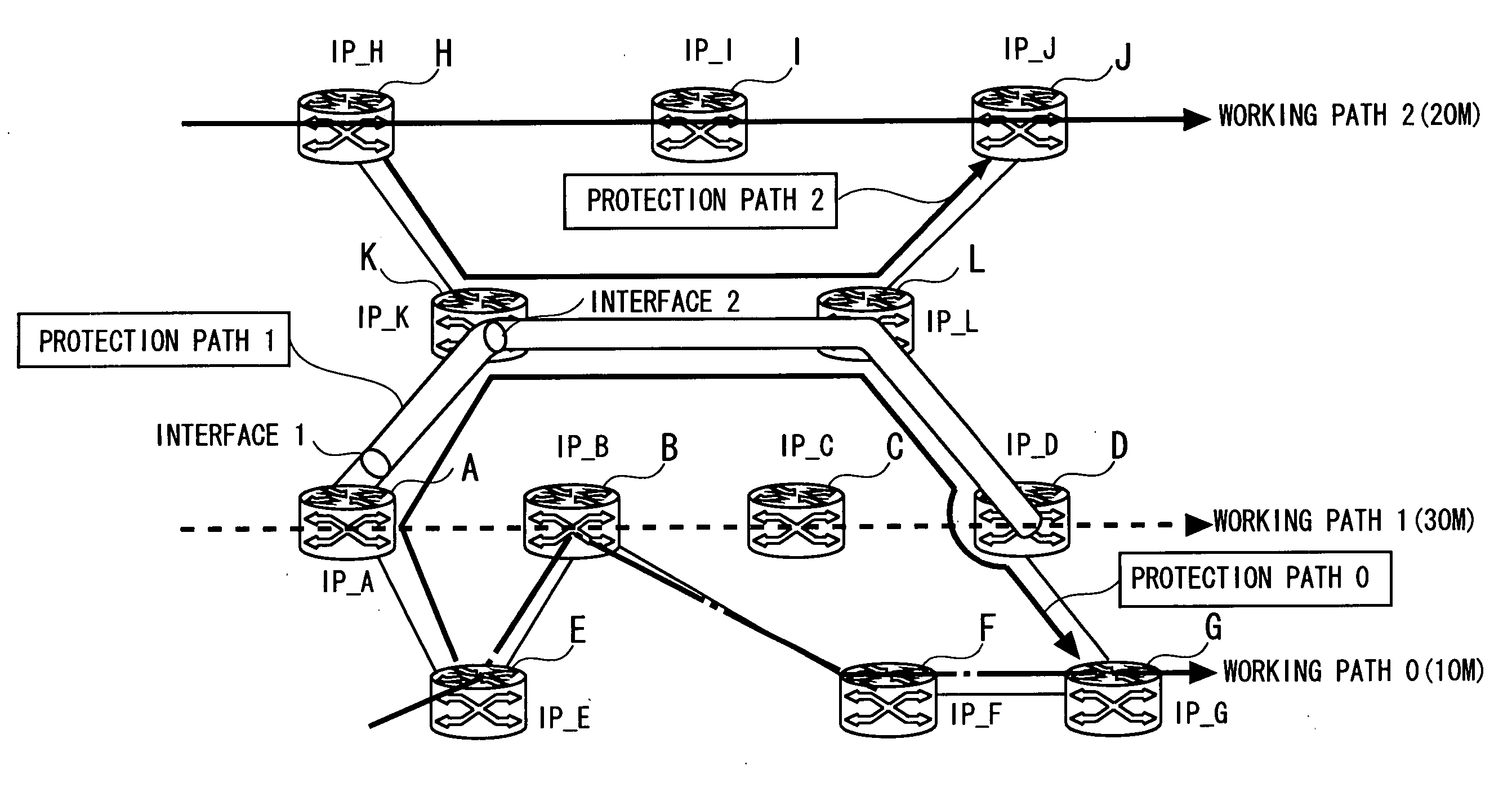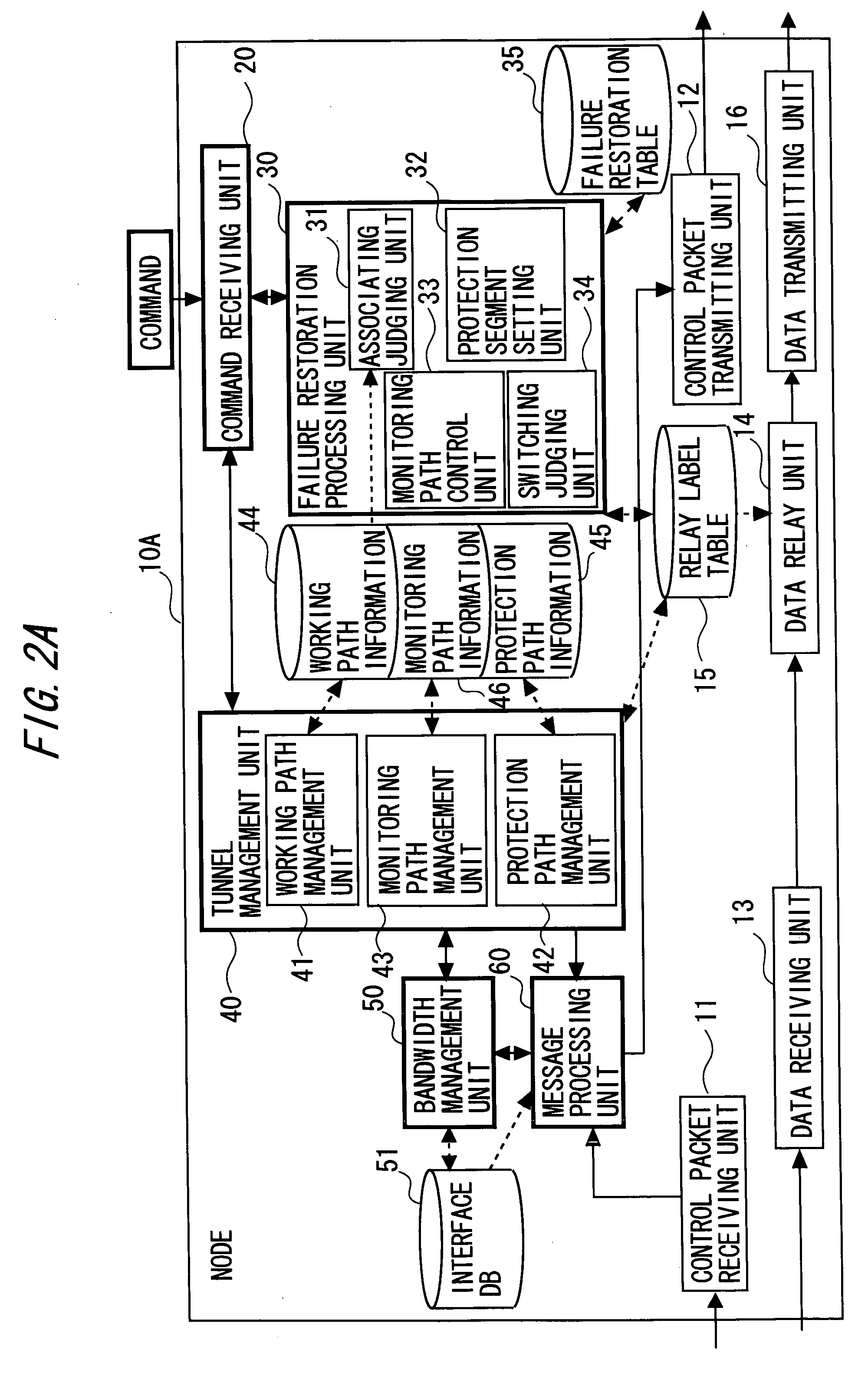Connection-oriented network node
a network node and network node technology, applied in the field of connection-oriented network nodes, can solve the problems of requiring enormous spare resources, affecting the operation, and both logical links suffering failures, and achieve the effect of efficient setting up a protection path and a monitoring path
- Summary
- Abstract
- Description
- Claims
- Application Information
AI Technical Summary
Benefits of technology
Problems solved by technology
Method used
Image
Examples
operational example 1
[0126] Next, an operational example of the network system will be described. To begin with, an operational example 1 will exemplify how an originating node (PLR) of the protection path executes setup of the protection path (a case where the protection segment is explicitly designated).
[0127] Herein, it is assumed that on the network illustrated in FIG. 1, a protection path 1 (A→K→L→D) protecting a segment (A→B→C→D) of a working path 1 is newly set. In the operational example 1, when setting up the protection path, the protection path is automatically associated with the working path. Further, a monitoring path for the working path is generated.
[0128]FIG. 5 is a sequence diagram showing a process of the originating node (the node A) of the protection path 1 in the operational example 1. When the protection path is set, a protection path generating command is inputted to the originating node of the protection path. Herein, the protection path generating command is inputted to the no...
operational example 2
[0182] Next, a bandwidth check (an automatic bandwidth sharing computing process) in all nodes that the protection path passes, will be explained by way of an operational example 2
[0183]>
[0184] As a premise of the discussion on the operational example 2, signaling for establishing a path and forwarding of a data packet will be explained.
[0185] The protection path is, as stated above, set (established) by the signaling of the protection path from the originating point (head-end) node. In the first embodiment, LSP setup (MPLS TE-LSP setup) using RSVP (RFC3209) “RSVP-TE: Extensions to RSVP for LSP Tunnels” in MPLS Traffic Engineering (MPLS TE) for setting up a path (LSP) by an end-to-end scheme, is applied as the signaling for setting up the working path, the protection path and the monitoring path. Note that RSVP (Resource Reservation Protocol) as a basic protocol is defined in RFC2205.
[0186] In the MPLS TE-LSP setup, a PATH message defined as a path setup request message is sent f...
operational example 3
[0210] Next, an operation of how the head-end node (PLR) of the protection path sets up the protection path in the case of designating none of the protection segment, will be explained by way of an operational example 3. Without even designating the protection segment when inputting a command to the head-end node, it is feasible to search for the protectable working path and to associate this working path with the protection path.
[0211]FIG. 15 is a sequence diagram showing an operation of the head-end node in relation to the setup of the protection path in the operational example 3. In FIG. 15, the same processes as those in the operational example 1 shown in FIG. 5 are marked with the same step numerals.
[0212] The operational example 3 is based on the assumption of a case of setting up, for instance, subsequently to the establishment of the protection path 1 explained in the operational examples 1 and 2, a new protection path 2 (route: nodes H→K→L→J) without designating the prote...
PUM
 Login to View More
Login to View More Abstract
Description
Claims
Application Information
 Login to View More
Login to View More - R&D
- Intellectual Property
- Life Sciences
- Materials
- Tech Scout
- Unparalleled Data Quality
- Higher Quality Content
- 60% Fewer Hallucinations
Browse by: Latest US Patents, China's latest patents, Technical Efficacy Thesaurus, Application Domain, Technology Topic, Popular Technical Reports.
© 2025 PatSnap. All rights reserved.Legal|Privacy policy|Modern Slavery Act Transparency Statement|Sitemap|About US| Contact US: help@patsnap.com



